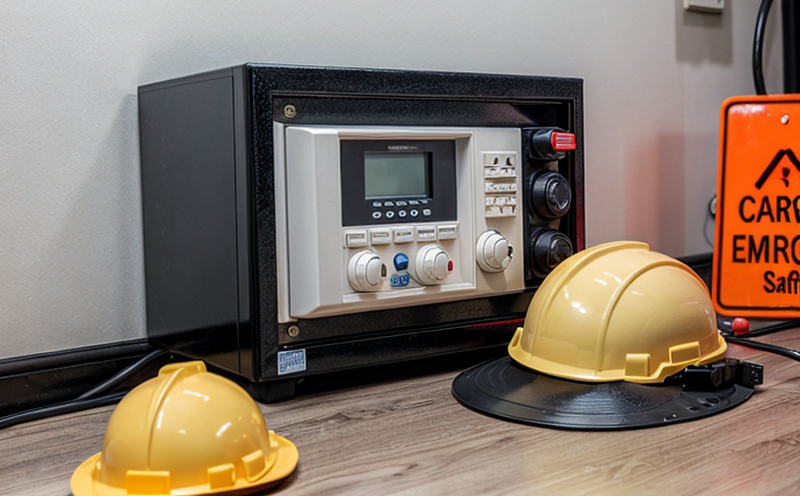SAE AS 8049 Aircraft Seat Safety Testing
The SAE AS 8049 standard is a critical component in ensuring the safety of passengers and crew by defining the requirements for seat belt assemblies used in commercial aircraft. This test evaluates the dynamic performance, strength, and durability of these critical safety devices under simulated emergency landing conditions.
Developed by the Society of Automotive Engineers (SAE), this standard is widely recognized as a benchmark for assessing the reliability of seat belts across various aircraft models. The testing protocol involves simulating an impact scenario that replicates the forces experienced during a severe crash, allowing manufacturers to validate their products against stringent safety criteria.
The process begins with meticulous preparation of the test specimens, which include dummy occupants positioned in the seats equipped with the seat belts being tested. These dummies are designed to mimic the mass and distribution of human bodies under various loading conditions. The test setup then subjects these configurations to controlled impacts using hydraulic drop towers or similar apparatus.
The primary objective is to measure key performance indicators such as belt strength, load sharing between belts, and restraint effectiveness during deceleration. Compliance with SAE AS 8049 ensures that seat belts can withstand the extreme forces encountered in an emergency landing without failure, thereby safeguarding passengers and crew.
The standard also emphasizes the importance of consistent testing methodologies to ensure reproducibility and reliability across different manufacturers. This consistency is crucial for maintaining high safety standards within the aviation industry. Furthermore, it allows for comparative analysis between various seat belt designs and materials, facilitating continuous improvement in safety features.
In addition to the static and dynamic tests prescribed by SAE AS 8049, modern laboratories incorporate advanced instrumentation and software tools to capture detailed data on force distribution, deformation patterns, and energy absorption characteristics. These insights are invaluable for refining both design parameters and manufacturing processes, ultimately contributing to safer aircraft interiors.
The implications of adhering to this standard extend beyond mere compliance; it reflects a commitment to passenger safety and well-being. By prioritizing rigorous testing protocols like SAE AS 8049, aviation companies not only meet regulatory requirements but also enhance their reputation for quality and reliability in the global market.
In conclusion, the implementation of SAE AS 8049 is essential for maintaining stringent safety standards in commercial aircraft. It underscores the importance of robust testing practices that align with international norms and contribute to a safer flying experience for all passengers and crew members.
Why It Matters
The SAE AS 8049 standard holds immense significance in the aerospace industry due to its direct impact on passenger safety. By mandating rigorous testing of seat belt assemblies, this standard ensures that these critical components perform reliably under extreme conditions. The importance of such testing cannot be overstated, as even minor deficiencies could have catastrophic consequences during an emergency landing.
The standard addresses several key aspects:
- Dynamic performance: Ensures belts can withstand sudden deceleration forces without failure.
- Strength evaluation: Validates the structural integrity of seat belts under simulated crash scenarios.
- Durability assessment: Checks for long-term reliability and resistance to wear and tear.
The results from these tests provide critical data that inform design improvements, material selection, and manufacturing processes. This not only enhances product quality but also fosters innovation within the industry. Moreover, compliance with SAE AS 8049 is often a prerequisite for certification by aviation authorities worldwide.
In essence, the standard serves as a vital tool in risk management, helping manufacturers identify potential weaknesses early on and rectify them before they reach operational use. This proactive approach significantly reduces the likelihood of accidents caused by faulty seat belts, thereby protecting public safety.
Why Choose This Test
Selecting SAE AS 8049 for your testing requirements offers numerous advantages that align with your organizational goals and regulatory obligations. Here are some compelling reasons to consider this standard:
- Regulatory Compliance: Ensures adherence to international safety standards, facilitating smoother certification processes.
- Innovation Facilitation: Provides a robust framework for developing cutting-edge seat belt technologies.
- Risk Mitigation: Identifies and addresses potential issues early in the development lifecycle, minimizing risks post-market deployment.
- Consistency Assurance: Ensures uniformity across different batches and models of seat belts.
- Customer Confidence: Builds trust with stakeholders by demonstrating commitment to high safety standards.
- Competitive Edge: Positions your company as a leader in aviation safety, enhancing brand reputation.
The comprehensive nature of SAE AS 8049 testing makes it an indispensable tool for quality assurance and product development. By leveraging this standard, you can enhance the overall safety profile of your products while meeting stringent industry expectations.
Environmental and Sustainability Contributions
The pursuit of environmental sustainability in aerospace is increasingly driven by global initiatives aimed at reducing carbon footprints and promoting eco-friendly practices. In this context, the SAE AS 8049 testing protocol plays a crucial role by emphasizing sustainable design principles.
One major aspect is the selection of materials that offer both safety and environmental benefits. For instance, lightweight yet robust materials are favored for their ability to reduce aircraft weight without compromising structural integrity or safety features. Such advancements contribute significantly to lower fuel consumption and emissions, thereby supporting broader sustainability goals.
Additionally, testing procedures that ensure optimal performance under various conditions help minimize material waste during manufacturing processes. This efficiency not only reduces resource usage but also decreases energy consumption associated with production cycles.
The standard's emphasis on durability further supports sustainable practices by promoting the longevity of seat belts and other critical components. Longer-lasting products mean less frequent replacements, reducing both operational costs and environmental impacts over time.
In summary, SAE AS 8049 aligns seamlessly with broader sustainability efforts within the aerospace sector. By focusing on material efficiency, performance optimization, and lifecycle management, this standard helps drive more sustainable aviation practices while maintaining unparalleled safety standards.





